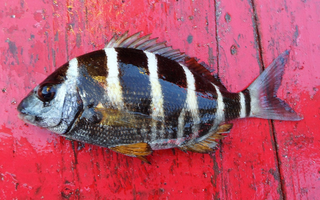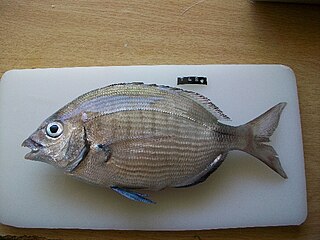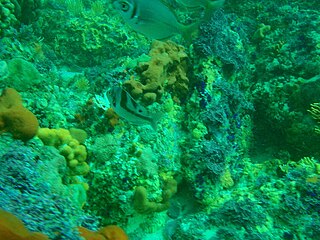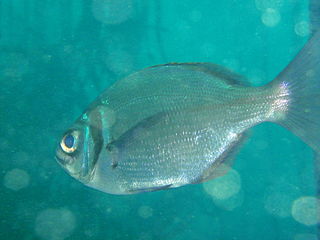
Lithognathus is a genus of marine ray-finned fish belonging to the family Sparidae, which includes the seabreams and porgies. Species in this genus are given the common name of steenbras. The genus is found in the Eastern Atlantic Ocean from southwestern Europe to South Africa and into the southwestern Indian Ocean.

The saddled seabream, also called the saddle bream or oblade, is a species of ray-finned fish belonging to the family Sparidae, which includes the seabreams and porgies. It is the only species in the monospecific genus Oblada. This species is found in the Eastern Atlantic Ocean. It is an important food fish within its range.

Boops is a genus of marine ray-finned fishes belonging to the family Sparidae, the seabreams and porgies. There are two species in this genus, one in the Western Atlantic and Mediterranean, and the other in the Western Indian Ocean.

Chrysoblephus gibbiceps, the red stumpnose, red stumpnose seabream or Miss Lucy, is a species of marine ray-finned fish belonging to the family Sparidae, the seabreams and porgies. This fish is endemic to the southwestern Indian Ocean off the coast of South Africa. The International Union for Conservation of Nature classifies this species as Endangered.

Chrysoblephus laticeps, the red roman or roman seabream, is a species of marine ray-finned fish belonging to the family Sparidae, the seabreams and porgies. This fish is endemic to Southern Africa, ranging from Namibia to the Eastern Cape.

Diplodus is a genus of marine ray-finned fish belonging the family Sparidae, which includes the seabreams and porgies. These fishes are found in the Atlantic Ocean, the Mediterranean Sea and the western Indian Ocean.

Acanthopagrus is a genus of marine ray-finned fishes belonging to the family Sparidae, the sea breams and porgies. The fish in this genus are found in the Indian and western Pacific Oceans.

Cheimerius is a monospecific genus of marine ray-finned fish belonging to the family Sparidae, the seabreams and porgies. The only species in the genus is Cheimerius nufar, the santer seabream, santer or soldier, of the Indian Ocean.

Chrysoblephus puniceus, the slinger seabream, is a species of marine ray-finned fish belonging to the family Sparidae, the seabreams and porgies. This species is found in the southwestern Indian Ocean where it is endemic to Southern Africa.

Crenidens is a small genus of three species of seabream from the family Sparidae from the western Indian Ocean. It was previously regarded as monotypic, with the sole species being the Karenteen sea bream Crenidens crenidens but two other species are now accepted as valid species, separate from the type species, C. crenidens.

The banded seabream is a species of marine ray-finned fish belonging to the family Sparidae, which includes the seabreams and porgies. This species is endemic to Cape Verde in the eastern Atlantic Ocean.

Argyrozona is a monospecific genus of marine ray-finned fish belonging to the family Sparidae, the seabreams and progies. Its only species is Argyrozona argyrozona, the carpenter seabream or doppie, which is endemic to the waters off southern South Africa.

Diplodus hottentotus, the zebra, is a species of marine ray-finned fish belonging to the family Sparidae, which includes the seabreams and porgies. This fish is found in the Western Indian Ocean off Southern Africa.

Diplodus capensis, the Cape white seabream or blacktail seabream, is a species of marine ray-finned fish belonging to the family Sparidae, which includes the seabreams and porgies. This fish is found around the coasts of Southern Africa.

Chrysoblephus anglicus, the Englishman seabream, is a species of marine ray-finned fish belonging to the family Sparidae, the seabreams and porgies. This fish is endemic to Southern Africa.

Chrysoblephus is a genus of marine ray-finned fishes belonging to the family Sparidae, the sea breams and porgies. The fish in this genus are found in the western Indian Ocean and southeastern Atlantic Ocean.

Chrysoblephus cristiceps, the daggerhead seabream or dageraad, is a species of marine ray-finned fish belonging to the family Sparidae, the seabreams and porgies. This fish is endemic to the southwestern Indian Ocean and southeastern Atlantic Ocean off South Africa. This species is assessed as being Critically Endangered bt the International Union for Conservation of Nature.

Gymnocrotaphus is a monospecific genus of marine ray-finned fish belonging to the family Sparidae, which includes the seabreams and porgies. The only species in the genus is the Gymnocrotophus curvidens, the Janbruin, an endemic to the coasts of South Africa.

Booposoidea is a monospecific genus of marine ray-finned fish belonging to the family Sparidae, the seabreams and porgies. The only species in the genus is Boopsoidea inornata, the Fransmadam or Karel grootoog, which is endemic to the southwestern Indian Ocean off South Africa.

Pachymetopon is a genus of marine ray-finned fishes belonging to the family Sparidae, which includes the seabreams and porgies. The species in this genus are endemic to Southern Africa.




















